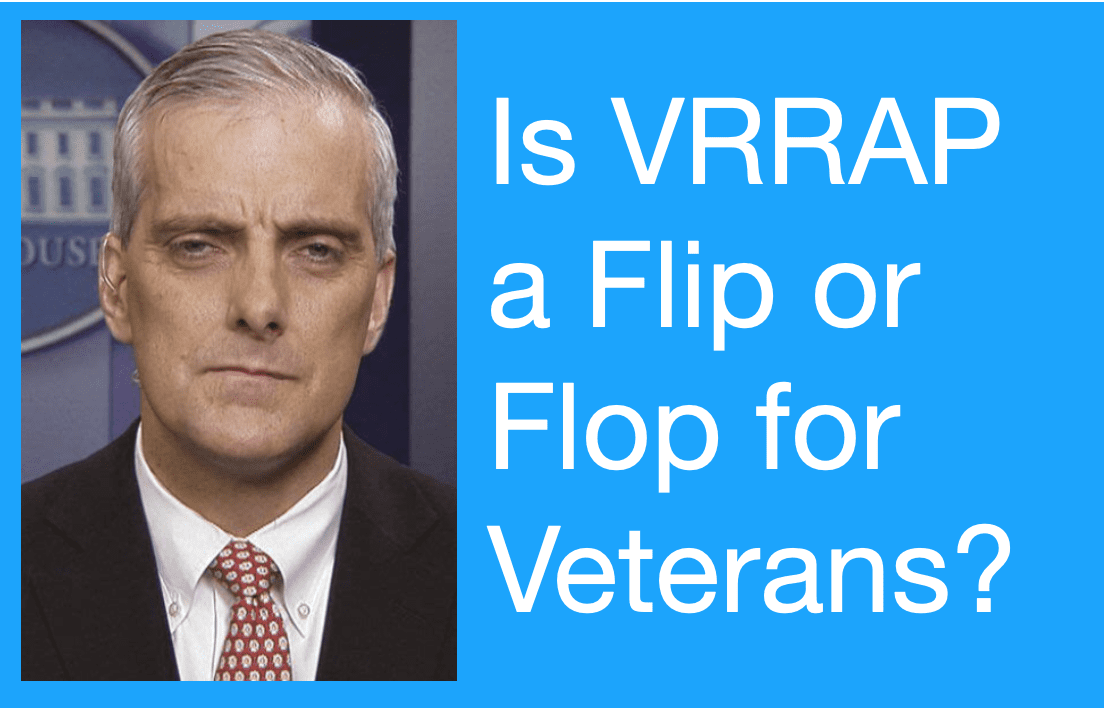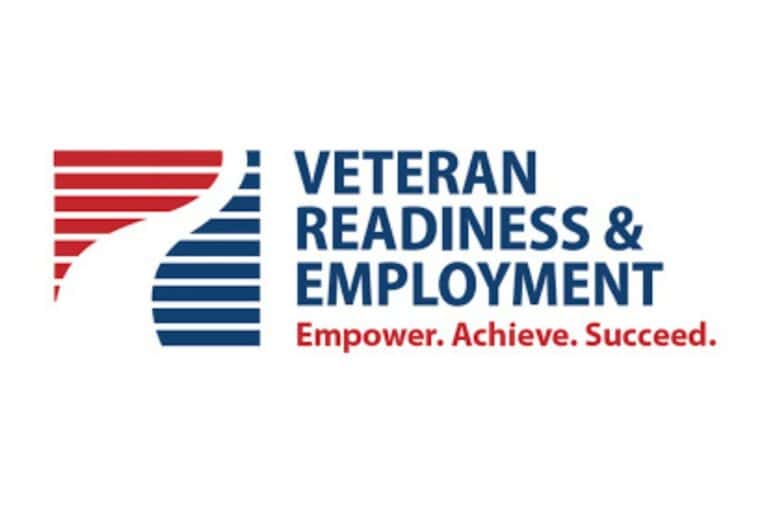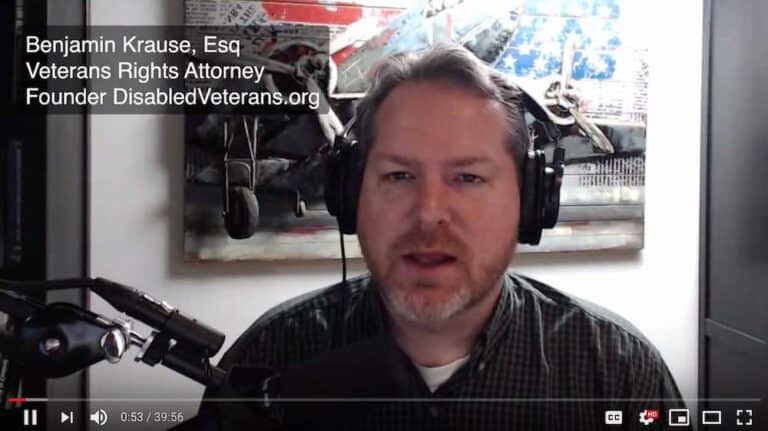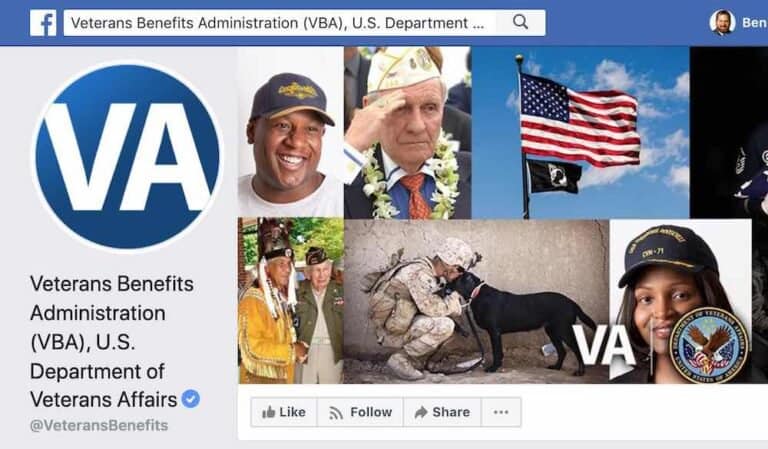Flip or Flop: Will VRRAP be a VA Sec McDonough Success?
The Veteran Rapid Retraining Assistance Program (VRRAP) stood to make a huge impact for veterans impacted by the pandemic with its whooping nearly $400 million budget.
Lots of money. Huge support from lawmakers and stakeholders alike. What could go wrong?
Apparently, a lot can go wrong with a program when policymakers create a massive program with little interest from the community it’s supposed to serve.
The budget matters little when few veterans use the program.
MilitaryTimes covered the story last week in what seemed like a preemptive disclaimer from VA officials trying to explain why VRRAP numbers stink.
Why VRRAP Sounds Like A Flop
On March 11, 2021, President Biden signed rapid retraining program into law as part of the American Rescue Plan of 2021. The program was created to help unemployed veterans receive GI Bill style support when retraining.
Good so far. And God knows, veterans need as much help as we can get when hit by unemployment during the pandemic.
The program would be spearheaded under authority of VA Secretary Denis McDonough, a prior White House chief of staff during the VA health care wait time scandal under former President Obama in 2014.
McDonough enjoys support across the aisle and seems professional when speaking with members of the news media and lawmakers.
VRRAP policy capped enrollment to 17,250 participants. This would give a decent population size to explore whether a program of this scope could work.
And as noted, lawmakers allocated nearly $400 million in funding for the program. That’s a lot of funding.
An applicant could not be eligible for any other training program, and they needed to pursue a high-demand occupation.
Retraining programs like this can be good for both the participant and taxpayers when they run correctly. It’s widely known within vocational rehabilitation programs that successful participants eventually pay back the cost of their training within a few years of working through tax payments.
The logic goes, then, that similar programs that focus on training successful applications should likewise result in a benefit not just to the individual but the tax coffers.
So far, so good.
Veterans apparently didn’t get the memo about the program being great as few veterans actually participated. After 8 months, only 3,400 veterans are participating in the program.
VA Education Service program integration officer Ricardo Da Silva said only 700 have graduated from training. And, of that, around 70 found new jobs through the program.
Of the total funds allocated, VA has only committed around $100 million due to the lack of interest. Whatever monies are not spent will be returned to the US Treasury.
Interesting issue. It sounds like VA is already considering it a flop.
But doesn’t it seem a little early to measure the success of the program? I mean, the program has not been out for a year, and it only provides veterans with 1 year of benefits.
Perhaps that might explain the low graduation numbers since we are only at the eight-month mark, no?
I started writing this story Sunday evening and could have published it then as is, following the establishment narrative published by MilitaryTimes. But something about the narrative made little sense, so I decided to let it percolate.
RELATED: Quick Facts – Veteran Readiness & Employment (Another Retraining Program)
More To The Story?
First, VA rarely admits defeat, ever, and especially not to MilitaryTimes or elsewhere unless there is something else going on.
In this context, the program has not even reached a full term of 12 months for veterans perhaps taking the entire one year of benefits.
700 veterans have graduated. Only 70 have found jobs. Is that due to problems with the program or problems with the job market or a failure within VA by not allocating resources to help the participants find work after graduation?
By focusing only on veteran graduates in programs that last 8 months, we seem to be limiting the sample from many veterans attending programs that last 8 months or longer.
Da Silva provided a fair amount of anti-VRRAP arguments including comparison with the VETTEC program and admitting to shortfalls in how the program was developed.
VETTEC Comparison
A similar program called Veteran Employment Through Technology Education Courses (VETTEC) launched in 2019 with a $100 million budget had significantly better success. Da Silva said that program saw 1,700 graduates finding new employment with an average salary of $60,000.
RELATED: VR&E Renames Itself
Something Wrong? Rapid Retraining Options
Lawmakers are considering making VETTEC a permanent benefit within VA but are puzzled about the poor numbers from VRRAP.
“This committee worked closely with VA to develop [the program] and set the funding based off of anticipated veteran demand for the program,” said Rep. Mike Levin, D-Calif., chairman of the House Veterans’ Affairs Committee’s economic opportunity panel.
Apparently 5,000 people were eligible for the program who received initial approval but did not follow through.
A veteran whose employment was adversely affected by the pandemic can use VRRAP but only if they exhausted all other education training benefits, first.
The training is limited to only high-demand occupation, which may create a bit of the problem.
The rapid retraining program was provided a list of occupations by the Department of Labor. A review of the list of 228 occupations reveals a subtle problem.
The program limits veterans to 12 months of training, and the training types are limited to completion of an Associate’s Degree, Non-Degree program, or Certificate.
Meanwhile, and I am not joking here, the list created by Labor included occupations that require significant schooling and/or training that cannot be accomplished in 12 months:
- Chief executive – Master’s in Business Administration
- Commercial pilot – Pilot’s license with flight ratings
- Respiratory therapist – Master’s / Doctorate
- Chemist – Doctorate
- Art Director – Master’s in Fine Arts
- Aerospace engineer – Bachelor’s Degree plus Licensure
- Mediators – Juris Doctorate, Certification
- Accountant – Bachelor’s Degree plus Licensure
- Human resources manager – Master’s in Human Resources
- Emergency management directors – Graduate degree
- Space scientist – Doctorate
Don’t get me wrong, the list also included occupations that require significantly less training like paralegal and barber and actor, but a large chunk of occupations was dedicated to high-demand occupations that require significant training and time.
In Minneapolis, a person training to cut hair might attend Aveda, whose training programs last 7-13 months.
Paralegal training at Inver Hills Community College takes more than one year.
As for becoming an actor, well, I’m not sure if there’s a program suitable under VRRAP.
RELATED: Veterans in Caregiver Program get Adopted
VA VRRAP Benefit Eligibility
The training goal is to learn a new skill or complete a certificate program. VRRAP gives veterans up to 12 months of tuition, fees, and monthly housing allowance payments. The amounts are based on Post-9/11 GI Bill benefits amounts.
Participants are being trained for employment in high-demand occupations.
To qualify, veteran must meet the following criteria:
- At least 22 years old, but not older than 66, and
- Unemployed because of the COVID-19 pandemic, and
- Not eligible for GI Bill or Veteran Readiness and Employment (VR&E) benefits
- (or, if eligible for the Post-9/11 GI Bill, you’ve transferred all of your benefits to
- family members), and
- Not rated as totally disabled because you can’t work, and
- Not enrolled in a federal or state jobs programs, and
- Not receiving unemployment benefits (including CARES Act benefits)
VA VRRAP High-Demand Occupations
The VRRAP program provides training toward an Associate’s Degree, Non-College Degree, or Certificate that leads to a high demand occupation. The “high demand occupation” list was a requirement of the American Rescue Plan Act of 2021 compiled by the Commissioner of Labor Statistics.
Some of the occupations on the list may raise an eyebrow when compared to the limited timeframe for training.
I am only listing a few from each grouping, and I did not need a $400 million budget to figure out what might be holding the program back.
Management Occupations
- Chief executives
- General and operations managers
- Marketing managers
- Sales managers
- Human resources managers
Business and Financial Operations Occupations
- Management analyst
- Human resource specialist
- Fundraiser
- Marketing research analyst
- Accountants and auditors
- Personal financial advisors
- Loan officers
Computer and Mathematical Occupations
- Computer systems analysts
- Information security analysts
- Computer network architects
- Computer programmers
- Actuaries
- Data scientists
Architecture and Engineering Occupations
- Aerospace engineers
- Bio-engineers and biomedical engineers
- Chemical engineers
- Electrical engineers
- Mechanical engineers
Life, Physical, and Social Science Occupations
- Environmental engineering technologists
- Animal scientists
- Soil and plan scientists
- Zoologists and wildlife biologists
- Chemists
Community and Social Service Occupations
- Substance abuse, behavioral disorder, and mental health counselors
- Child, family, and school social workers
- Clergy
- Directors, religious activities, and education
- Health education specialists
Legal Occupations
- Arbitrators, mediators, and conciliators
- Paralegals and legal assistants
Education Instruction and Library Occupations
- Kindergarten teachers
- Postsecondary teachers
- Library technicians
- Museum technicians
- Special education teachers
Arts, Design, Entertainment, Sports, and Media Occupations
- Art Directors
- Fine artists
- Special effects artists
- Actors
- Coaches and scouts
Healthcare Practitioners and Technical Occupations
- Dietitians and nutritionists
- Radiation therapists
- Respiratory therapists
- Nuclear medicine technologists
- Surgical technologists
Healthcare Support Occupations
- Nursing assistants
- Occupational therapy assistants
- Massage therapists
- Medical assistants
- Physical therapist assistants
Protective Service Occupations
- First-line supervisors of firefighting and prevention workers
- Firefighters
- Fire inspectors and investigators
Personal Care and Service Occupations
- Barbers
- Hairdressers, hairstylists, and cosmetologists
- Makeup artists
- Manicurists
- Skincare specialist
Sales and Related Occupations
- Securities, commodities, and financial services sales agents
- Sales representatives
- Sales engineers
Office and Administrative Support Occupations
- Bookkeeping, accounting, and auditing clerks
- Court, municipal, and license clerks
- Order clerks
- Human resources assistants
- Statistical assistant
Construction and Extraction Occupations
- Carpenters
- Electricians
- Glaziers
- Plumbers
- Structural iron and steel workers
Installation, maintenance, and repair occupations
- Farm equipment mechanics
- Motorcycle mechanics
- Millwrights
- Commercial drivers
- Wind turbine service technicians
Production Occupations
- Machinists
- Water and wastewater treatment plan and system operators
- Computer numerically controlled tool programs
- Molders, shapers, and casters
Transportation and Material Moving Occupations
- Airline pilots, copilots, and flight engineers
- Commercial pilots
- Captains, mates, and pilots of water vessels
- Motorboat operators
- Ship engineers
VRRAP Approved Education Institutions
If you are still reading this, perhaps you are interested in the free money and tuition that comes with the program.
VA published a list of rapid retraining certificate programs and associate’s degree programs being offered throughout the national.
Curiously, the largest lists of approved programs belong to two Kentucky schools, Bluegrass Community and Technical College in Lexington and Somerset Community College in Somerset.
Most of the occupation list provided by the Department of Labor are not in fields where a veteran can get trained within 8 months, which was the focus of the story. Again, VA chose to come out with this information through a senior official.
Why?
Most occupations on the list require graduate training. Many others require at least more than 12 months of training to qualify if starting from zero.
Instead, the program seems to be a booming opportunity to fund certain community colleges and vocational institutions. Listed above are two that stand to benefit substantially, both in Kentucky, should VA fill the spots.
As for the overall cost, VA is allocated $23,188 per veteran. That seems to be a lot of money for a certificate program or associate’s degree training that lasts no more than 12 months, right?
When you subtract out the monthly subsistence payment, through, $1,500 times 12 months comes to $18,000. It leaves only $5,188 for cost of training for those who use the full entitlement.
Instead, what I think is happening, if I were a betting man, would be VA is trying to stick a fork in the program now to reconfigure or allocate the funds to another program.
Either someone failed to do their homework by setting up a program that would not work, or, the program was not designed to work right. Either way, there is a lot of money out there soon to be returned to the US Treasury if more veterans don’t get access to the help.
Please comment below if you have experience with VRRAP. Maybe it will help solve the riddle of the underused but massively funded benefit.




One of the main issues creating the lack-of-use is the failure to define *focus* of the program.
As it was explained to me, the benefit is meant to help Veterans who already have viable baseline or even advanced skills, but need, want, or require additional training or education to become “competitive in the job market”.
So…it’s not aimed at a machine-tool technician who lost their job and wants to become a Video Game Designer (or a Software Developer, or etc…); it’s aimed at a machine-tool technician who wants to get trained up on something new and cutting-edge in the machine-tool market (say the administration of Linux-based controllers in creating or operating such tooling).
*That* is actually do-able in 12 months. The problem vets I know have is that they aren’t unemployed, they are under-employed, or had to take a “lesser” job.
To me and the vets I know who could actually use the program, the mountain of qualifying requirements is the primary limiting facto, with the problem of getting a course or school “approved” a close second.
It also seems that some of the VA administrators are confused about what kind of program qualifies, which would be another VA internal training failure.
I totally agree with your assessment Mr Krause! Typical government incompetence. Having dealt with the Dept of Labor before I can assure you they have no clue of the skills and/or training it takes for most jobs! They have lists made up by someone clueless and they just pass them along with no upgrades, changes or considerations to whether the lists are correct. I have no idea how they determine what is a high demand job but I do know they are wrong most of the time. I’ve been looking for a job as an Animal Scientist for over 30 years and might have seen a listing 2-3 times. The only high demand jobs now are nursing (huge demand), electricians, plumbers, HVAC/Cooling (huge demand), and other building trades and manufacturing to some extent. Thanks for clarifying for us.
Here we go AGAIN.
*”https://www.military.com/daily-news/2022/02/10/va-hospital-warns-thousands-of-vets-of-possible-infection-risk-improperly-cleaned-equipment.html?ESRC=eb_220211.nl”*
Will the Veterans Administration never learn?
I was struggling to keep up with child support and go to school using the Texas Hazelwood Act (150 hours tuition grant) . My choice was PT and I applied for the VRRAP program to be denied because I was told I didn’t respond to the letter sent. After three years of struggle I happened to go back to the office and out of the blue a supervisor called me into his office and straightened the counselors lies out. I was in and told to choose between three careers even though I had almost completed all the pre req,s for PT with good standing. I went for a BSRC-sat for boards and made RRT as a 2020 graduate and got paid up and done with child support with help from Jesus.
To start this whole process from the beginning, I had to initiate by relocating and paying first quarters tuition and praying for reimbursement that would come but was always at the last moment and with great distress due to lack of communication with the counselors.
As a post graduate looking back in 2022, I can say I started two different jobs on my own even though no hospital would hire me as a new graduate. VA employment assistance was a joke. In retrospect, I never felt like this program was doable for the average impoverished veteran and the level of help from VRRAP counselors is not consistent bordering on psychotic to workable. Today, Because of my back injuries that are service connected, I struggle with this occupation that VRRAP made me select . Don’t misunderstand, I feel blessed to have experienced college with no debt and Be able to work as a RRT in the LTACH environment even though new graduates 55 years old are not hired by hospitals because they want 2 years experience. Going to work at the VA is out because experimental vaccination with its side effects is not my choice. My advice for others is to never give up and stay flexible because VA assistance will require your utmost attention to get through to the other side and then you can focus on the studies. Be strong.
Over the years I have been treated like crap.
Like a second class citizen
I have friends and others who say the same thing.
Especially the Vietnam Vets.
We are and have been considered a drug crazed bunch of heathens.
So many have gave there life in one way or another and are treated like a plague.
That war separated this country and it never got back to the garden.
I say the people in charge and their friends make trillions of dollars over young men and women’s dead cold bodies and don’t care.
I’m using the program to attend film school- it seems that I will run out of time before finishing my program, so not sure how I’ll then get a job in the field with an unfinished certificate. Lots of other veterans in my school- the school heavily recruited us. I’m hoping that an extension will be given as my 12 months comes up. It’s a confusing program .
Can you use any other benefit to finish your schooling?
I wish you luck!
*”https://www.independent.co.uk/news/world/americas/us-politics/joe-biden-crack-cocaine-program-b2010830.html”*
I have been working with PTSD and combat vets from Vietnam mostly getting some minimal amt of justice with PTSD disability. Thirty five years and first 10 years I gave the VA the Benefit of Doubt Rule to the VA and the Compensation Dept. Finally I could ignore no longer the BS and Broken System/Corrupt Culture anymore. This Dept comes up with so many New and Better Program concepts (so they say) but the actual results are far from even being adequate much less Helpful for the vets they serve. Catchy phrases abound Very little positve results occur. BS and schuck and jive is what I have seen in the 36 years of fighting to get any Justice for the vets that they are mandated to HELP.
*”https://www.independent.co.uk/news/world/americas/us-politics/joe-biden-crack-cocaine-program-b2010830.html”*
How many vets got their free crack pipes?
I noticed there’s funds to help veterans with “substance abuse”! I wonder, did any vet receive their “free crack” pipe from the $30 million the biden administration set aside for this!
Don’t believe me! It was just reported that the biden administration paid $30 million taxpayers dollars to give crack pipes to junkies!
Come on brother, you don’t have to agree with the premise of the program, but there is no reason to make lite of a serious problem for many , many fellow veterans !! Your comments just come across as equally disrespectful to vets fighting for their lives against addiction and sour grapes about a lost election. We aren’t garden variety, unremarkable masses , we are citizen soldiers who swore an oath to hold ourselves to a higher calling , to lead by example, and if necessary to hold the line for those still to come . If not us , then who , if not now , then when ?
B.S. this crap about what you just said is B.S.! This drug addiction by vets should be treated and stopped – not helped along by this corrupt administration!
I could care less about you think!
Thank you! I’m sorry to see so many fellow soldiers are so gullible among other things. Guess I shouldn’t be surprised as they are no different from the rest of society, and when you have Mike Flynn and other higher ups gone bad you have to expect the lower ranks to copy cat. Very sad but hopefully the majority is still willing to stand up for democracy. I am.